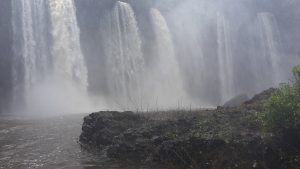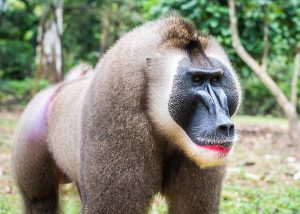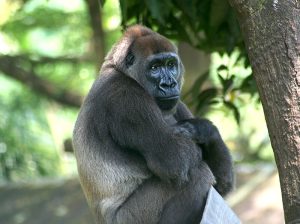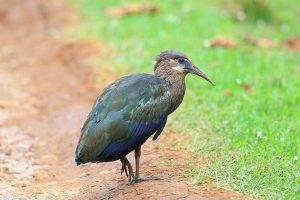Positioned on the edge of Cross River National Park, visitors are immediately surrounded by a harmonious display of natural beauty. Located in Cross River State, Nigeria, in the southeastern corner of the country, this expansive wilderness showcases the magnificence of nature. Encompassing 4,000 square kilometres, it is recognised as Nigeria’s largest closed-canopy rainforest, a lush gem within Africa’s ancient forests.
Cross River National Park, divided into two separate divisions known as Okwangwo and Oban, showcases remarkable diversity. Established in 1991 and 1988, these divisions are home to a wide range of ecosystems, each with its own unique story. Oban, the larger division spanning over 3,000 square kilometres, dominates the landscape with its rugged terrain that demands respect. From the gradual slopes in the south to the towering peaks reaching 1,700 meters in the north, the park’s landscape is both diverse and breathtaking.
Enveloped by lush greenery, a diverse array of wildlife flourishes. Among the towering trees of the rainforest, 16 different primate species call this place home, from the impressive Cross River gorillas to the elusive drills and charming common chimpanzees. The melodious songs of birds echo through the air, while secretive creatures of the forest floor contribute an element of intrigue to this untouched sanctuary. Cross River National Park serves not only as a refuge for animals but also as a vivid illustration of the delicate balance of nature.
This park holds the prestigious title of being a biodiversity hotspot designated by the United Nations. It serves as more than just a wildlife sanctuary; it stands as a symbol of optimism for conservationists across the globe. Its importance extends beyond national boundaries, as it joins forces with Cameroon’s Korup National Park, creating an unbroken expanse of safeguarded wilderness.
For individuals looking to experience the beauty of Cross River National Park fully, the Kanyang tourist village is a must-visit destination. Located just an hour from Calabar, it serves as a perfect entry point to this wild environment, offering necessary facilities and acting as a central point for discovery. Kanyang showcases a lodge for relaxation, a restaurant for delightful dining experiences, and a wildlife museum for a deeper understanding of the park’s diverse ecosystem. It truly exemplifies the peaceful cohabitation of mankind and the natural world.
Step into Cross River National Park, where every rustle of the leaves and every chirp of a bird tells a story of resilience, beauty, and the enduring bond between humanity and the natural world.

Overview
Covering a vast expanse of 4,000 square kilometres, Cross River National Park is divided into two separate sections: Okwangwo and Oban. These areas showcase a diverse range of ecosystems, ranging from the tall canopies of humid tropical rainforests to the peaceful mangrove swamps by the shoreline. As one of Nigeria’s biggest rainforest regions, it serves as a hub of biodiversity, housing various rare species and cultural landmarks.
The Cross River National Park, situated in Nigeria’s Cross River State, is composed of two separate divisions: Okwangwo, which was established in 1991, and Oban, established in 1988. This park stands as Nigeria’s most extensive rainforest and is among the oldest in Africa, being acknowledged by the United Nations as a biodiversity hotspot. The park’s terrain is rugged, with elevations ranging from 150 meters in the south to 1,700 meters in the north. Its northern and central areas predominantly consist of moist tropical rainforests, while the coastal zones showcase mangrove swamps. Within the Oban Division, there are hills that exceed 500 meters in elevation, with one peak reaching nearly 1,000 meters.
The park is home to a diverse range of primates, totalling 16 species, including common chimpanzees, drills, Cross River gorillas, and grey-cheeked mangabeys. Additionally, the park is home to five endemic monkey subspecies, one endemic monkey species, and one endemic ape subspecies, showcasing its rich and unique primate population. Covering approximately 3,000 square kilometres, the Oban Division is the largest area of closed-canopy rainforest in Nigeria and shares a border with Cameroon’s Korup National Park. The Oban Division holds significant importance as a watershed, characterized by hills that exceed 500 meters in height, with one peak reaching an impressive height of around 1,000 meters. During the last glacial period, the Oban Hills served as a refuge for lowland rainforest, and today, they are globally recognized as a hotspot for biodiversity and a hub for species richness and endemism, particularly for primates, amphibians, butterflies, fish, and small mammals.
Oban is home to several rare and unique species, including the Nigeria-Cameroon chimpanzee (Pan troglodytes ellioti), the drill (Mandrillus leucophaeus), the leopard (Panthera pardus), the forest elephant (Loxodonta cyclotis), the grey-necked rockfowl (Picathartes oreas), and the slender-snouted crocodile (Mecistops cataphractus). In addition, Oban is the exclusive habitat in Nigeria for the Preuss’s red colobus monkey (Procolobus preussi) and the crowned guenon (Cercopithecus pogonias). The contiguous Oban-Korup forest is renowned as the most biodiverse site in Africa for butterflies and is also considered one of the most diverse and rich bird-watching sites in Nigeria.
The Okwangwo Division was established in 1991, created from three former forest reserves, and it spans an area of 640 square kilometres, primarily consisting of lowland and sub-montane closed canopy forest., Situated at the headwaters of the River Cross, its terrain varies from 150 meters in the southern lowlands to approximately 1,700 meters on the northern edge of the Obudu plateau. Okwangwo shares its borders with Takamanda National Park in Cameroon, and collectively they serve as a crucial habitat for the critically endangered Cross River gorilla (Gorilla gorilla diehli) and several other significant species, including the Nigeria-Cameroon chimpanzee (Pan troglodytes ellioti), the drill (Mandrillus leucophaeus), Preuss’s guenon (Allochrocebus preussi), the forest elephant (Loxodonta cyclotis), and the grey-necked rockfowl (Picathartes oreas).

Despite its ecological significance, Okwangwo faces extensive hunting activities, resulting in notably low populations of large mammal species. The predominant hunting methods involve wire snares and shotguns, primarily to meet the demand of the bushmeat trade, and also for the ivory from forest elephant hunting. Furthermore, the montane forests on the outskirts of the Obudu plateau are progressively deteriorating due to grassland fires. Within the park, three enclave villages have emerged as hubs for hunting, providing refuge for poachers, while the expansion of farmlands within these village enclaves is gradually encroaching on the park, causing a physical divide. Illegal logging, especially for ebony, has become an escalating concern, further contributing to the environmental challenges. The gathering of non-timber forest products, like bush mango, is widespread, often leading to the establishment of large camps inside the park, attracting both gatherers and hunters.
A Brief History
The genesis of Cross River National Park can be traced back to the late 20th century, when conservationists with a vision laid the groundwork for its establishment. Despite encountering challenges such as illegal logging and poaching, ongoing conservation efforts are dedicated to safeguarding the park’s precious ecosystems. Initiatives involving partnerships and community engagement are currently underway to ensure the longevity of the park for future generations.
The Cross River National Park (CRNP) in Nigeria was officially established in 1991, emerging from three former forest reserves. Although the park was initially proposed in 1965, significant planning did not commence until 1988. The establishment of the park was supported by the World Wide Fund for Nature (UK) with a budget of $49.9 million, playing a crucial role in its creation. The park’s theme animal, the Cross River gorilla, serves as a symbol of its unique biodiversity.
CRNP is a rainforest biodiversity hotspot, covering 640 square kilometres of closed canopy forest, primarily consisting of lowland and sub-montane areas. The park’s rugged topography features elevations ranging from 150 meters in the southern lowlands to 1,700 meters on the edge of the Obudu plateau in the north. The Cross River and its tributaries flow into the park, giving rise to swamps in the northern part of the Oban Hills division.
The park is situated in Cameroon and borders the Takamanda and Korup national parks. Located southeast of Obudu Town, the Okwangwo Division of the CRNP is bounded by the Cross River to the south, the Ikom-Obudu Highway to the west, and the Cameroon frontier to the east. In the Oban Division of the CRNP, one can find Preuss’s red colobus monkey and the crowned guenon, making it the only location in Nigeria where these species can be found. Furthermore, the Oban-Korup forest is renowned as the richest site in Africa for butterflies.
Since its establishment, CRNP has been tackling significant challenges, including illegal logging and poaching. To address these challenges, ongoing conservation efforts are being pursued, supported by partnerships with international organizations and active engagement with local communities. The primary goal of these initiatives is to protect CRNP’s biodiversity and ensure the long-term sustainability of the park for the benefit of future generations.
Ecological Diversity
Discover a world of extraordinary ecological variety, where every part of the park reveals a unique wonder. Cross River National Park (CRNP) in Nigeria is a haven for a wide range of plants and animals, from the lush rainforests to the vast savannahs. Within its boundaries, you’ll find rare and endangered species, such as the elusive Cross River gorillas and magnificent African forest elephants, seeking safety and protection.
The park boasts an impressive array of ecological diversity, featuring:
- Mammals: home to 119 species, including 75 mammal species such as forest elephants, chimpanzees, drills, and buffalo, as well as 18 of the 23 monkey species found in Nigeria.
- Birds: With 382 bird species, including the olive green ibis, and 410 species across 53 families, CRNP is one of Africa’s most diverse lowland sites for birds.
- Fish: Contains 48 fish species and 140 species in the Korup area, distributed among three river systems.
- Snakes: host 42 snake species.
- Butterflies: It comprises 950 butterfly species, with almost 600 species collected by Torben Larsen in the Oban division in 1995.
- Plants: It supports 1,568 plant species, including 77 endemic to Nigeria, such as 1,303 flowering plants, 141 lichens, and 56 moss species.
- Mushrooms: There are 79 mushroom species in the Oban Hills Division, belonging to 54 genera and 36 families.
CRNP also protects unique species such as the subspecies of gorilla (Gorilla gorilla diehli) and bare-headed rock fowl (Picathartes oreas), which are endemic to the area. The Oban Hills division is an internationally recognized biodiversity hotspot, especially for primates, amphibians, butterflies, fish, and small mammals.

The park harbours one of the oldest rainforests in Africa, further identified as a biodiversity hotspot. Sixteen primate species have been recorded in the park, with rare primates including common chimpanzees, drills, and (in Okwangwo) Cross River gorillas.

Visitor Experience
Cross River National Park (CRNP) in Nigeria is a haven for nature enthusiasts, providing a variety of activities to enjoy. Visitors can embark on breathtaking hikes through picturesque trails and have unforgettable encounters with wildlife, guaranteeing an extraordinary experience at every turn. The park also offers cosy accommodations within or close to its premises, ensuring a convenient and peaceful getaway into the heart of the wilderness.
Cross River National Park (CRNP) in Nigeria is a Pleistocene biodiversity refuge in the Guinean Forests of West Africa that offers many activities for visitors, including:
- Wildlife Viewing: Witness the park’s rich fauna, including gorillas, leopards, red foxes, baboons, buffaloes, elephants, drill monkeys, chimpanzees, and orangutans.
- Hiking: Traverse the lush rainforest vegetation and enjoy the diverse flora.
- Water Recreation: Enjoy the natural water bodies, such as the Kwa River, perfect for various water activities.
- Bird Watching: Spot a multitude of bird species that inhabit the park.
- Botanical Garden Tour: Explore the Botanical Garden and Herbarium in Button, showcasing a variety of plant species.
- Natural History Museum: Tour the museum within the park to learn about its rich natural history.
- Local Tours: Engage with the local communities and learn about their unique way of life.

The park experiences two distinct seasons: a dry season from November to March and a rainy season from March to November. During the dry season, which spans from November to March, the park encounters minimal rainfall, while the rainy season, occurring from March to November, brings abundant precipitation. The average daily temperature ranges from 14°C to 25°C, providing a moderate and comfortable climate for visitors throughout the year. The annual rainfall in the park ranges between 2000 and 3000 mm, contributing to the lush and diverse ecosystem within the park.
The Kanyang Tourist Village, conveniently located just an hour’s drive from Calabar, offers a convenient and comfortable base for visitors exploring the park. Visitors can enjoy the amenities of a lodge, a restaurant, and a wildlife museum at the Kanyang Tourist Village, ensuring a comprehensive and enjoyable experience during their stay.
CRNP’s main tourism potential lies in a wide array of activities, including gorilla watching, bird watching, mountaineering, hiking, fishing, and boat cruising. In addition, visitors can explore a small zoological garden showcasing rare species, marvel at the scenic Kwa Falls, and be awed by the breathtaking Agbokim Waterfalls, all contributing to an unforgettable adventure in Nigeria’s captivating natural environment.
Challenges and Conservation Outlook
The Cross River National Park is facing significant challenges that threaten its delicate balance and splendour. One of the major challenges is the illegal logging that has become a growing problem, particularly for ebony, within the park. Poaching is also a rampant issue, with three enclave villages within the park serving as hunting hotspots and sanctuaries for poachers. The expansion of farmlands through slash-and-burn farming is gradually dividing the park into two, posing a critical issue for its conservation. Cattle herding and fishing, as well as water poisoning, are major threats to the park’s biodiversity. Furthermore, illegal entry and the collection of non-timber forest products (NTFP) further worsen the situation, highlighting the urgency of conservation efforts to address these challenges.
The Cross River National Park (CRNP) is considered a global conservation hotspot and stands as one of Nigeria’s most valuable conserved areas. It is recognized as a ‘biodiversity hotspot’ due to its rich and varied resources, encompassing diverse flora, fauna, rivers, and topography. Unfortunately, the park is facing a significant threat from illegal activities, jeopardizing its valuable resources. Efforts are being made to address this issue through collaborative strategies and a renewed dedication to sustainability, offering hope for a future where the park can flourish as a symbol of biodiversity. Promoting eco-tourism can play a crucial role in preserving the park’s fauna, while also providing support to villagers in buffer zones to engage in sustainable forestry practices, thereby reducing the impact of human activities. By effectively tackling these challenges with viable solutions, the CRNP can continue to serve as a vital sanctuary for Nigeria’s natural heritage.
Final Note
Nestled in the Cross River National Park lies a sanctuary of diverse wildlife and a remarkable example of the connection between nature and humans. This protected area holds great historical and ecological value, offering a special chance to explore Nigeria’s untamed wilderness. However, the park’s existence depends on carefully managing the balance between conservation and sustainable development.
The Cross River National Park is a symbol of hope, showing nature’s strength and inspiring efforts to protect our planet’s beauty. With conservationists, locals, and tourists working together, the park can thrive and safeguard its rainforests, wildlife, and cultural treasures for generations to come.
As we move forward into the future, it is important to carry with us the stories passed down by the ancient trees, the melodies of the diverse birdlife, and the quiet resilience of the elusive Cross River gorillas. These memories serve as a powerful reminder of our responsibility to protect these sanctuaries, as preserving Cross River National Park is a tribute to its exceptional beauty and the timeless connection between humanity and the environment.



